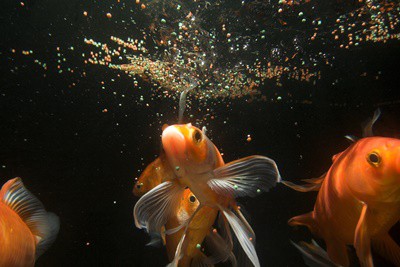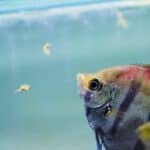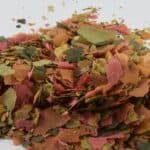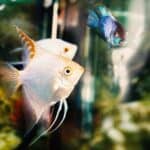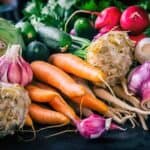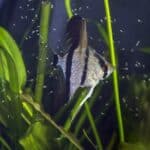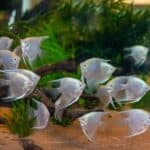Feeding your pet fish a nutritionally balanced diet is essential to their well-being.
If you’ve run out of fish food, you must find them something to eat to prevent them from going hungry. You may also want to mix their diet to provide the additional nutrients they need.
Fish can eat various foods, including hard-boiled egg yolks, seafood, rice, and pasta. Blanched vegetables, like peas, broccoli, cucumber, lettuce, carrots, zucchini, and spinach, are filling and nutritious.
You can also feed fish fruits, including apples, bananas, pears, berries, pears, and oranges. You mustn’t feed fish any dog or cat food. Also, bread isn’t a healthy fish food substitute.
Fish can be omnivores, herbivores, or carnivores. This means their nutritional requirements differ, and some need more specific foods than others to stay healthy.
What Can Fish Eat Besides Fish Food?
There’s plenty that fish can eat besides traditional flakes and pellets.
Before you deviate from their everyday diet, double-check what nutrients the fish need so that you can provide them with the healthiest food for their requirements.
Not all fish are the same, and they all need different vitamins and minerals to survive.
If you’re wondering what human food fish can eat, you can feed them the following:
Vegetables
If you’re looking for nutritious alternative fish food, you likely have a selection of vegetables. Most fish can eat blanched vegetables as they provide essential vitamins and minerals fish need to thrive.
However, vegetables are high in carbohydrates, which some species need less than others.
As described by the MSD Veterinary Manual, carbs lead to fatty liver disease, so you should replenish the fish food as soon as possible.
Cook the following vegetables and offer small amounts to the fish to keep them from going hungry:
Peas
Peas are among the best vegetables to feed fish.
They’re higher in fiber than most, which keeps their digestive systems healthy. They ease bloating and constipation by flushing out the system and can help treat dropsy and swim bladder disease.
Frozen organic peas contain the most nutrients without the chemicals, additives, and preservatives. Cook them first before giving them to the fish to provide the following nutrients:
- Vitamin A.
- Vitamin C.
- Calcium.
- Iron.
Broccoli
As long as you blanch or boil broccoli before serving, it’s perfectly safe for fish to eat. Raw broccoli is far too harsh for fish, so cooking it beforehand softens it.
It’s also easy to overfeed broccoli as the florets are large, so cut it up into small pieces first.
Broccoli is an excellent source of the following:
- Fiber.
- Protein.
- Calcium.
- Vitamins A, C, E, K.
- Iron.
- Folic acid.
- Potassium.
- Selenium.
- Magnesium.
In particular, selenium is a crucial nutrient. Animal Science Database describes how it protects cell membranes and tissues from oxidative stress.
It also helps fish develop and grow, keeping their scales and skin healthy.
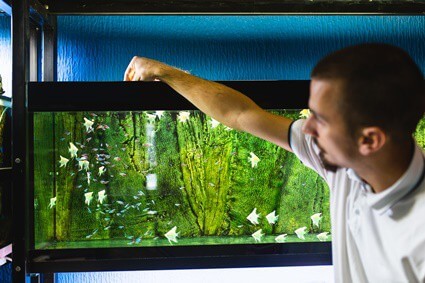
Cucumber
Most fish take to cucumbers well. They’re soft and watery, making them easy for fish to eat.
Cut them into tiny pieces so your fish can scoop them up with their mouths. They’ll struggle to swallow the pieces otherwise.
Most of the nutrients are in the skin, so refrain from peeling cucumbers to get the full health benefits.
Just remember to wash the cucumber first to remove any pesticides or chemicals. Also, remove the seeds because most fish won’t eat them.
Cucumbers contain the following nutrients:
- Fiber.
- Vitamin C.
- Vitamin K.
- Magnesium.
- Potassium.
- Manganese.
Lettuce
Lettuce is another soft, easy-to-eat vegetable. Fish enjoy picking at the leaves so that you can put relatively large ones into the tank for mental stimulation.
Red leaf lettuce is the easiest to chew, but iceberg and romaine are also acceptable.
Lettuce contains the following nutrients:
- Vitamin A.
- Vitamin C.
- Vitamin K.
- Calcium.
- Fiber.
Lettuce is notorious for harboring pesticides, so you must wash the leaves thoroughly before giving them to your fish.
Carrots
Carrots are good for fish, and they’re a vegetable most homes have. They’re also easy to grow in the garden, just in case you run out of fish food again. Raw carrots are too hard, so boil them first to soften them. Slice them into thin pieces so that your fish can eat them.
Canned carrots aren’t suitable, as they contain preservatives and additives to prevent them from decomposing too quickly. Fresh carrots are okay, as long as you defrost them first.
You can also put carrot leaves into the tank, as they’re just as healthy, and fish love leafy plants.
Zucchini
Zucchini is similar to cucumber and is widely accepted by most plant-eating fish. Before feeding it to your fish, cut it into thin slices, leaving the skin on, and blanch it to soften it.
Similar to cucumber, remove the seeds, as they’ll remain in the tank uneaten otherwise.
Zucchini contains several nutrients, including:
- Potassium.
- Manganese.
- Folate.
- Fiber.
- Vitamins A, C, and K.
While zucchini is healthy, It contains lots of water. Over time, this can cause diarrhea, which appears as a brown, murky tinge in the tank.
Spinach
Fish need protein for their growth. Spinach is an excellent source of plant-based protein and is one of the most nutritionally dense vegetables. This means you can use it as a healthy replacement for your usual fish food for a short while. As well as protein, spinach contains:
- Vitamins A, B2, C, and K.
- Calcium.
- Folate.
- Magnesium.
- Manganese.
- Iron.
Be mindful of spinach, though, as it contains oxalate, a chemical compound restricting the body’s ability to absorb calcium and iron. This is why spinach is only a short-term replacement for fish food.
Fruits
As well as vegetables, fish can eat a small selection of fruits. Like vegetables, you must thoroughly wash them beforehand to remove any potential pesticides. Organic fruits are better for fish, but standard fruit bowl produce is okay if you’re desperate for replacement food.
The following fruits are suitable for most fish:
Apples
Apples are an excellent fruit to feed fish, but they shouldn’t overeat them. Using apples as a supplement for your fish’s everyday food is safe if you don’t do it for too long.
To prepare the apple, peel the skin and cut it into tiny chunks. You might also want to soak it in water beforehand to soften the pieces. Apple contains:
- Fiber.
- Vitamins C and K.
- Potassium.
- Antioxidants.
- Calcium.
- Phosphorus.
- Magnesium.
Apple is acidic, which can cause stomach problems over time. It also contains water, which can lead to diarrhea if you overfeed it to your fish.
Banana
Banana is soft and protected by the peel, so it’s safe and healthy for fish. Omnivores should accept the fruit, but carnivorous fish won’t be too keen. Bananas are good for digestive health, containing dietary fiber, pectin, and resistant starches that boost gut function.
They also contain antioxidants that can help reduce the risk of diseases and health conditions. Bananas make fish feel full, so they’re an excellent replacement food for flakes and pellets.
As well as this, they contain:
- Copper.
- Potassium.
- Magnesium.
- Manganese.
- Fiber.
- Vitamins A, B6, B12, and C.
Pears
Raw pears are another healthy fruit. Be careful, though, as they’re usually grown where pesticides are used. To be on the safe side, peel the skin and cut it up into small chunks. Boiled pears are more manageable for fish to eat than raw, but you can soften them in water beforehand.
Pears are a rich source of:
- Copper
- Potassium
- Fiber
- Vitamin C
- Vitamin K
Oranges
Oranges contain citric acid, which gives them their sour taste. It also has several health benefits. However, too much can cause pH spikes and the tank’s ammonia levels to rise, so be careful with how much orange you feed your fish. Oranges are also a good source of:
- Flavonoids.
- Fiber.
- Antioxidants.
- Carotenoids.
- Vitamins A and C
Meat
Carnivorous fish need meat and prefer protein over carb-heavy fruits and vegetables.
Small slithers of cooked and unseasoned chicken, beef, or lamb are suitable – although not all fish will take to these flavors, especially if they’ve never eaten them before.
These meats also contain higher levels of saturated fat than fish are used to, so too much will make them ill. Also, these meats are unfamiliar to wild fish, so you shouldn’t regularly add them to their diet.
Many fish enjoy eating worms and other insects, but it’s not a wise idea to dig some out from the yard, as they could be covered in pesticides and other chemicals.
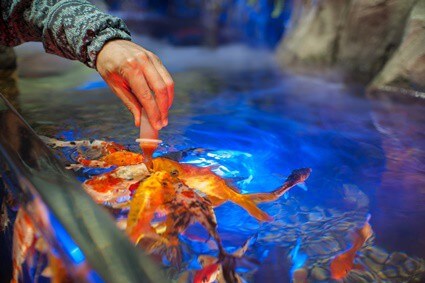
Seafood
Cooked prawns or other small pieces of seafood are enough to sustain carnivorous fish for a short while. Frozen seafood is suitable – defrost it first so it’s nice and soft and easy for fish to eat.
Rice or Pasta
Fish love to eat cooked pasta and rice. Most people store these items in a cupboard, which is a quick fix if you’ve run out of fish food.
Uncooked pasta and rice expand in the stomach, so cook it first. It’s also easy to overfeed fish, rice, and pasta, so be careful with how much you put into the tank.
Unfortunately, pasta and rice have little nutritional value for fish and contain no vitamins. They’re also high in carbohydrates, which is unhealthy for prolonged periods, making these food items strictly a short-term replacement for fish flakes.
Hard-Boiled Eggs
Many small fish enjoy hard-boiled eggs, so you shouldn’t have any difficulty encouraging them to eat the eggs you cook for them. They’re an excellent source of protein, keeping their nutrient levels adequately topped up while you look to replenish your usual fish food.
The particles can make the tank murky. Because eggs are high in protein, they can pollute the tank. But if you’re using eggs as a short-term supplement, it shouldn’t be a problem.
Just be sure to siphon out any uneaten parts before they affect the water.
Can Fish Eat Cat or Dog Food?
If you have no food for your meat-eating fish, you may wonder whether it’s a good idea to feed them some spare dog or cat food you have lying around. Unfortunately, this isn’t wise.
Commercial dog and cat food is specially formulated to cater to their needs, meaning they don’t contain the appropriate nutrients for fish.
As a result, it could destroy their immune systems, making the fish sick while tainting the water.
Can Fish Eat Bread?
Bread is a pantry staple, but it’s not safe to feed to fish. Bread is low in protein and other essential nutrients but high in carbs. Too much can damage your fish’s digestive system.
Bread also expands in water and the fish’s stomach, which can cause several health problems inside the gut. Bread might seem like a good choice if you have no fish food, but you should avoid it altogether.
Running out of fish food isn’t ideal, but it’s not too much of a problem if you have suitable foods in the house to use instead.
Blanch vegetables and wash all foods before serving them to your fish to keep them safe. That way, they’ll get essential nutrients until you can get hold of their usual flakes and pellets.

